Know Which Bin to Put Your Healthcare Waste In

The segregation of healthcare waste streams, including black bin waste in hospitals, can have significant implications for all sized healthcare facilities, which is why at Daniels we put so much focus on partnering with our customers to optimize their waste streams for best-practice waste segregation.
Some of the common risks and costs of incorrectly disposed waste include:
- Safety risk to staff and patients through exposure or unauthorized access to infectious wastes or controlled substances
- Compliance breaches and risk of fines for the incorrect disposal and treatment of hazardous materials
- Treatment complications imposing human and environmental risk from wrongly categorized hazardous wastes. (US law places the responsibility of all healthcare waste on the generator for its entire life cycle – this includes transport and treatment!)
- High cost implications for over-categorized waste. For example, incorrectly disposed solid waste into medical waste bins can incur a 50-80% disposal and treatment premium.
- Injuries occurring from sharps incorrectly deposited into general waste or red bags
Ensuring each waste type is correctly disposed of into its corresponding container is something we shine a spotlight on, because it protects the safety of your staff and ours! US legislation places significant importance around the collection, disposal and treatment of both medical waste and hazardous waste because of their risk impact to people and the environment. So much so, that if any hazardous and non-hazardous material were ever mixed together, the full bulk of the waste would be classified as hazardous and would need to be disposed of in accordance to hazardous waste regulations.
Let’s start with the color of the container…
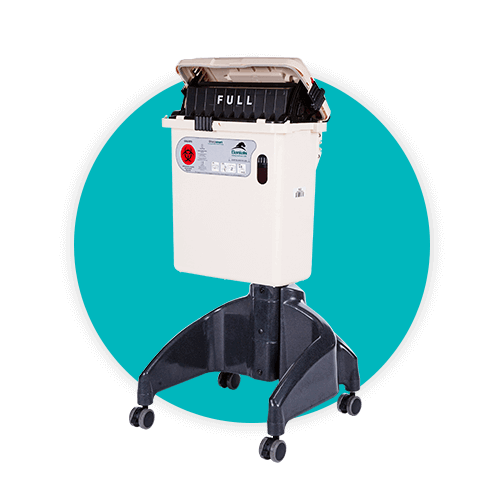 Sharps Waste
Sharps Waste
While sharps are classified as a biohazardous waste, they cannot be disposed of in a traditional biohazardous waste container or red bag. Daniels sharps containers are ivory in color to clearly differentiate the waste stream from the traditional red for non-sharp regulated medical waste. View Daniels Sharpsmart
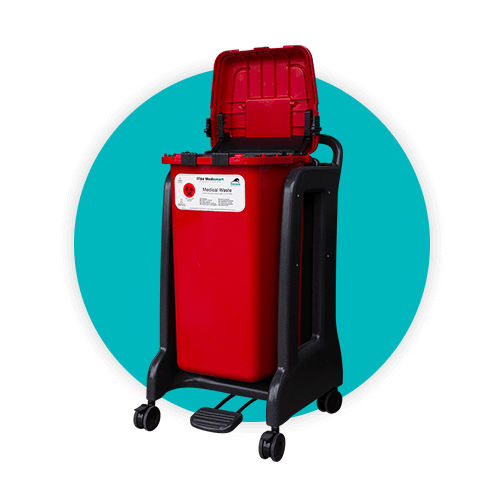 Regulated Medical Waste
Regulated Medical Waste
The OSHA bloodborne pathogens standard requires that a regulated medical waste container must be sealable, and closed prior to removal to prevent spillage during handling and storage. Daniels biomedical waste containers are red in color, clearly marked with a biohazard symbol, airtight and leakproof. View Daniels Medismart
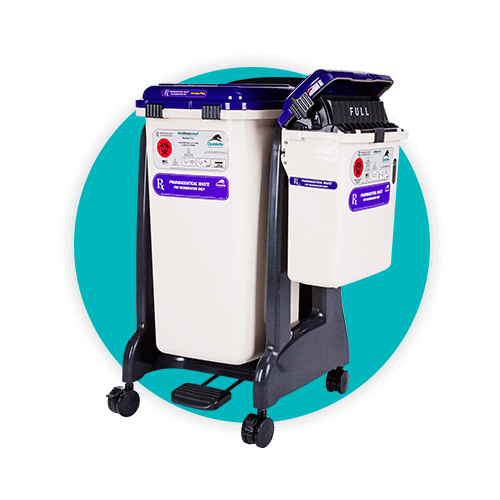 Non-Hazardous Pharmaceutical waste
Non-Hazardous Pharmaceutical waste
These pharmaceutical containers need to be clearly differentiated from hazardous containers due to the high human, environmental and compliance risk associated with incorrect disposal. Daniels pharmaceutical range of containers are designed with an ivory base with a purple lid for instant recognition. View Daniels Pharmasmart
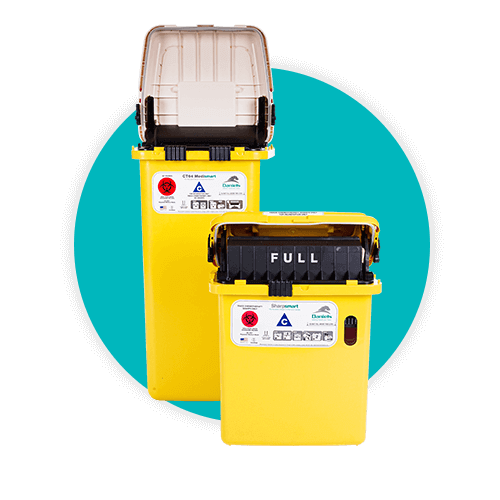 Trace Chemotherapy Waste
Trace Chemotherapy Waste
Chemotherapy waste is considered “trace” when less than a 3 percent by weight residual of the chemotherapy drug substance remains. In this residual form, the drug is classified “non-hazardous.” Daniels trace chemotherapy containers are yellow in line with industry standard. View Daniels Chemosmart
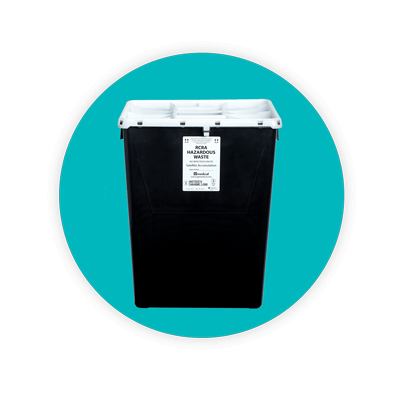 RCRA Hazardous waste
RCRA Hazardous waste
In accordance with the Resource Conservation and Recovery Act, RCRA Hazardous waste must be treated in a RCRA approved incinerator and must be clearly earmarked for hazardous listed waste. Daniels Hazardous waste containers are black in line with industry standard. View RCRA containers
A Closer Look at Managing Black Bin Waste in Hospitals
Although sometimes misunderstood, proper management of black bin waste is essential for cost-effective and environmentally responsible waste disposal. Here are some key points to consider:
- Clearly label black bins for general waste to prevent confusion with other waste streams
- Educate staff on what items can be safely disposed of in black bins
- Regularly audit black bin contents to ensure proper segregation
- Consider implementing recycling programs to reduce the volume of black bin waste
- Position black bins strategically throughout the facility to encourage proper disposal
By effectively managing black bin waste in hospitals, facilities can reduce costs, minimize environmental impact, and ensure compliance with waste management regulations.
Learn how to Segregate Waste Better
Container colors are quite easy to differentiate, but the harder area to navigate is what do you put in each bin.
There are some basic no-no’s when it comes to any healthcare waste disposal. For example you should never mix non-hazardous pharmaceutical waste with hazardous black bin waste in hospitals. However, there are other slightly more grey areas, such as how much blood or bodily fluids must be found on an item to render it biohazardous?
To give you a bit of a visual head-start on ‘what goes in this bin?’ we have created an easy to follow segregation poster.
How Daniels transforms segregation outcomes
At Daniels, we partner with all sized healthcare facilities to ensure their risk and costs are managed throughout the waste journey. Some of the ways we ensure full compliance and safety to your staff and the environment is maintained are as follows:
- Clearly labelled and color coded waste containers that make it clear to staff “which bin to put it in” with regards to medical waste, sharps, pharmaceutical, trace chemotherapy and hazardous waste disposal
- Education posters, webinars and in-house training on how to effectively segregate medical waste
- Waste mapping at a facility level to ensure the right containers are positioned at point of need and eliminate risk of incorrect disposal due to absent containers
- Per location Waste audits to identify challenge areas, and tailored action plans to train and correct behavior
- Monthly reporting to isolate unusual trends of waste volumes or costs
- Formulary analysis service to categorize every controlled substance your facility generates and determine the correct collection and disposal requirements
If you have questions about how to reduce costs associated with poor medical waste segregation or improving the risk profile of your facility, talk to one of our clinical experts today. For facilities that generate multiple healthcare waste streams, we would be happy to do an onsite assessment to identify areas of cost and safety improvements and map out a plan of how Daniels can partner with you to redefine the effectiveness of your healthcare waste segregation and biohazardous waste program. Call us at 855-251-2655 or e-mail us at hello@danielshealth.com
Let's Talk!
Your time is valuable, and we don’t want to play hard to get. You can either phone us directly on the details listed on our contact page, or feel free to fill out this short form and one of our team members will get back to you as quickly as possible.
